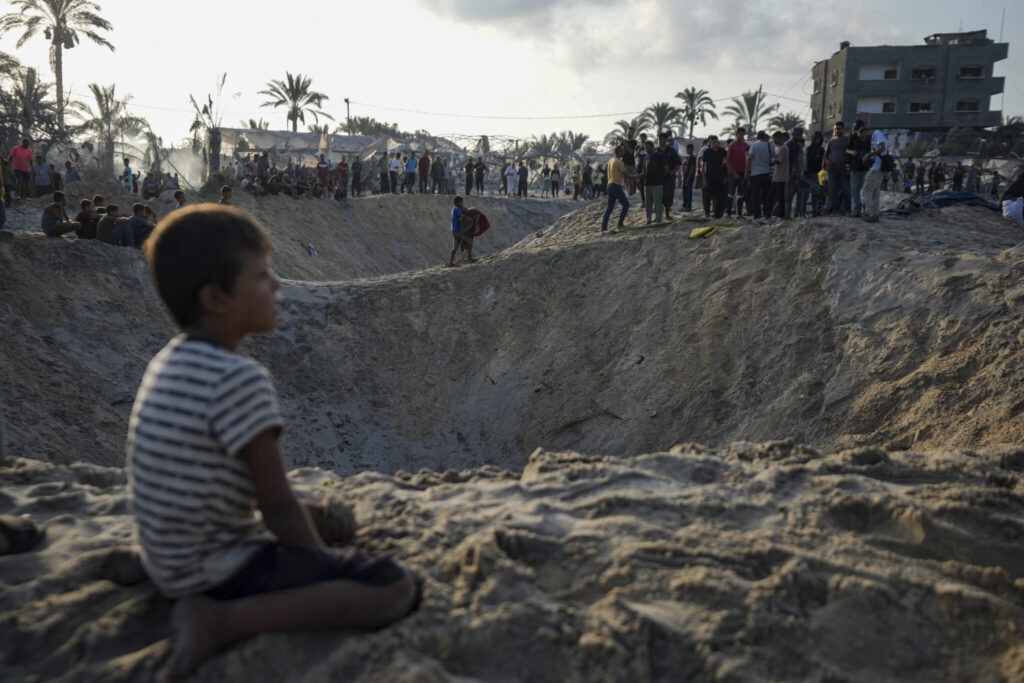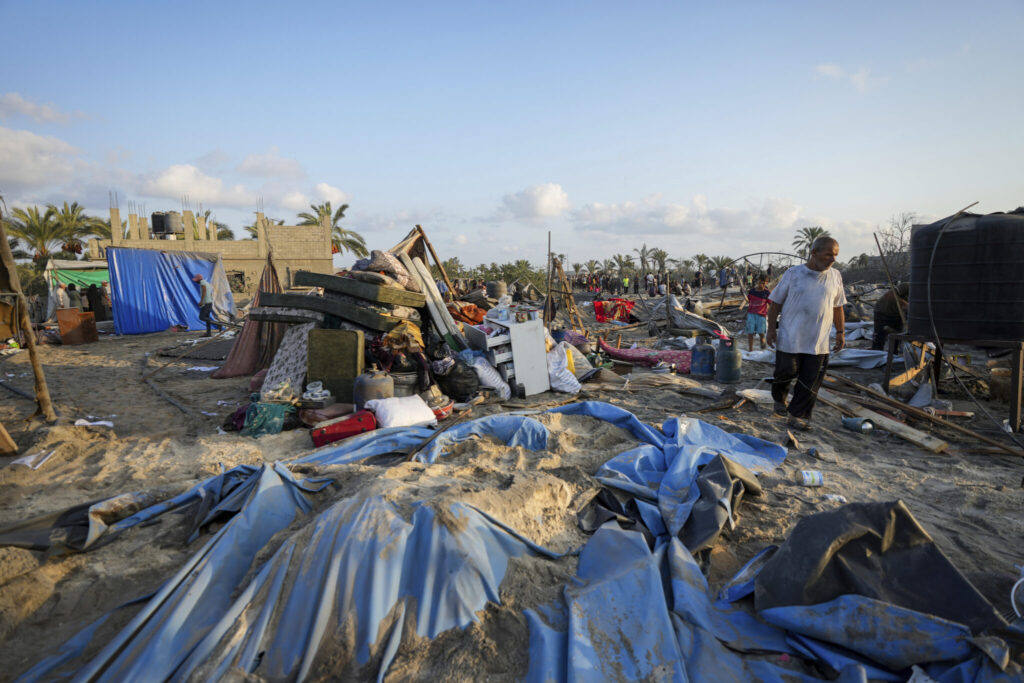Gaza airstrike casualties/ Israeli camp attack/ Hamas militants Gaza/ Newslooks/ DEIR AL-BALAH, Gaza Strip/ An Israeli airstrike on a Gaza humanitarian zone killed at least 19 Palestinians, with 60 wounded, according to Palestinian officials. Israel claimed the strike targeted senior Hamas militants. The war has displaced 90% of Gaza’s population.

Israeli Gaza Camp Strike: Quick Looks
- Casualties: At least 19 killed, 60 injured in the strike.
- Location: Muwasi camp, a humanitarian zone along the Gaza coast.
- Israeli Military Claim: Targeted senior Hamas militants involved in recent attacks.
- Palestinian Response: Disputed Israeli claims, calling them a “blatant lie.”
- Humanitarian Impact: Over 40,900 Palestinians have been killed since the conflict started.
Israeli Strike on Gaza Camp Kills 19 Civilians
Deep Look
An Israeli airstrike hit a crowded tent camp in Muwasi, a humanitarian zone along the Gaza coast, killing at least 19 people and injuring 60 others, according to Palestinian officials on Tuesday. The camp, designed as a refuge for Palestinians displaced by the ongoing war, was struck early in the morning. Israel’s military claimed the strike targeted senior Hamas militants, alleging they were responsible for recent attacks on Israel. This attack is one of many that have escalated tensions and destruction across Gaza since the conflict began.
The Gaza Health Ministry, which operates under Hamas, confirmed that 19 people died in the attack, with the toll possibly rising as rescue workers continue to search through the debris. While the Civil Defense, another entity under Hamas, initially reported 40 deaths, Israeli military officials disputed those figures, asserting that their munitions were used precisely and suggesting that the casualty numbers were lower than reported.
Footage captured by the Associated Press from the scene showed rescuers digging through sand and rubble in the early hours, using bare hands and flashlights. Among the wreckage, body parts were found, including a human leg. One camp resident, Iyad Hamed Madi, who had sought refuge in Muwasi, lamented the futility of the “safe zone” designation, showing a bag of diapers for his four-month-old child as evidence of the civilian toll. “Is he a fighter?” Madi asked bitterly.
At Nasser Hospital in Khan Younis, one of the hospitals receiving victims, around two dozen bodies were reported to have been brought in. An AP cameraman confirmed seeing 10 bodies, including those of women and children. Survivors shared their stories, including Samar Moamer, who lost one of her daughters in the attack while another was pulled from the wreckage alive.
In its defense, the Israeli military stated that it was targeting a Hamas command center embedded in the camp area, naming three senior operatives allegedly involved in planning attacks on Israel, including the October 7 attack that launched the current conflict. Rear Adm. Daniel Hagari, a spokesperson for the Israeli military, stood by the precision of the strike, dismissing early casualty reports as inaccurate.
Hamas, however, denied the presence of militants in the camp, labeling Israel’s justification a “blatant lie.” Neither side has presented concrete evidence supporting their claims.
Israel has continuously argued that Hamas deliberately operates within civilian areas, making it difficult to target militants without impacting non-combatants. The use of tunnels, rocket launchers, and command posts hidden in densely populated regions such as Muwasi is a known tactic of Hamas. Under international law, military strikes in civilian areas are permitted if the force used is proportionate to the military objective, though such assessments are highly disputed and rarely resolved in court.
The Muwasi camp has become a hub for displaced Palestinians as the war has caused massive displacement, with 90% of Gaza’s population of 2.3 million people having been forced from their homes, often multiple times. The Israeli military has issued widespread evacuation orders, pushing civilians into areas like Muwasi, where humanitarian aid has struggled to keep pace with the overwhelming need for basic services.
The Health Ministry of Gaza has reported over 40,900 Palestinian deaths since the war’s inception. The ministry’s figures, which include both militants and civilians, estimate that more than half of the casualties are women and children. On the other hand, Israel claims it has neutralized over 17,000 Hamas fighters during the conflict.
The war began in October, when Hamas-led fighters launched a devastating attack on Israel, killing around 1,200 people, mostly civilians, and abducting 250 others. While many of the hostages were released during a brief cease-fire, Hamas continues to hold approximately 100 people. Some of the remaining hostages are believed to have died, although this has not been confirmed.
Efforts by the United States, Egypt, and Qatar to broker a cease-fire and secure the release of hostages have been ongoing but remain mired in disagreements. Both Israel and Hamas have accused each other of introducing new demands, which have hindered progress. On Monday, Israeli Defense Minister Yoav Gallant suggested that conditions were favorable for a temporary six-week cease-fire that could lead to the release of more hostages. However, Gallant stopped short of committing to a permanent cessation of hostilities, as demanded by Hamas.
The war has brought Gaza to the brink of collapse, creating a severe humanitarian crisis. Aid organizations have found it nearly impossible to deliver essential supplies due to the continuous fighting and logistical challenges. The United Nations’ main agency for Palestinian aid, UNRWA, reported that on Monday, Israeli troops halted a convoy participating in a polio vaccination campaign for eight hours, despite prior coordination. The delay, along with damage to U.N. vehicles, caused setbacks to a campaign meant to vaccinate over 640,000 children in Gaza following the discovery of the first polio case in 25 years.
The Israeli military justified the stoppage, citing the presence of suspected militants within the convoy. While the suspects were questioned and later released, the disruption has further complicated efforts to provide aid to Gaza’s beleaguered population.
As the conflict continues, the civilian toll mounts, and the international community remains deeply concerned about the humanitarian catastrophe unfolding in Gaza.







